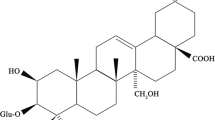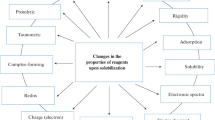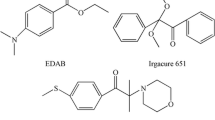Abstract
Microemulsion electrokinetic chromatography (MEEKC) has been developed for fingerprint analysis of resina draconis, a substitute for sanguis draconis in the Chinese market. The microemulsion as the running buffer was made up of 3.3% (w/v) sodium dodecyl sulfate (SDS), 6.6% (w/v) n-butanol, 0.8% (w/v) n-octane, and 10 mmol/L sodium tetraborate buffer (pH 9.2), which was also used as the solvent for ultrasonic extraction of both water- and fat-soluble compounds in the traditional Chinese medicine samples. Four batches of resina draconis obtained from different pharmaceutical factories located in different geographic regions were used to establish the electrophoretic fingerprint. MEEKC was performed using a Beckman PACE/MDQ system equipped with a diode-array detector and with monitoring at 280 nm. The fingerprint of resina draconis comprised 27 common peaks within 100 min. The relative standard deviations of the relative migration time of these common peaks were less than 2.1%. Through repetitive injection of the sample solution six times in 24 h, all relative standard deviations of the migration time and peak area of loureirin A and loureirin B were less than 2.5 and 3.8%, which demonstrated that the method had good stability and reproducibility. The relative peak areas of these common peaks in the electropherograms of four batches of resina draconis were processed with two mathematical methods, the correlation coefficient and the interangle cosine, to valuate the similarity. The values of the similarity degree of all samples were more than 0.91, which showed resina draconis samples from different origins were consistent. On the other hand, high-performance liquid chromatography (HPLC) coupled with photodiode-array detection was also applied to establish the fingerprint of resina draconis. The samples were separated with a LiChrospher C18 column using acetonitrile (solvent A) and water containing 0.1% H3PO4 (solvent B) as the mobile phase in linear gradient elution mode at a flow rate of 0.6 mL/min and detection was at 280 nm. There were only 20 common peaks in the HPLC fingerprint, and the values of the similarity degree of all samples were also more than 0.91. Though the similarity results of fingerprint analysis seemed to be the same, MEEKC resulted in more common peaks and higher separation efficiency for a variety of polarities of the components than HPLC. So, MEEKC was more suitable for development of the fingerprint of resina draconis.






Similar content being viewed by others
References
Cai XT, Xu ZF (1979) Acta Bot Yunnanica 1:1–10
China Pharmacopoeia Committee (2005) Pharmacopoeia of the People’s Republic of China. Public Health Department of China, Beijing, pp 96–97
Zhang QY, Zhu H, Chen HY (2004) Acta Acad Med CPAPF 13:69–71
Lin AP, Tu PF, Zheng JH (1994) Chin J Chin Med 19:648–650
Zhong L, Bi HM (2002) J Pharm Pract 20:332–334
Wen DX (2001) Chin Tradit Herbal Drugs 32:1053–1054
Sun SL, Mi HM, Wu SQ (2002) Chin Tradit Herbal Drugs 33:1033–1036
Zhang Q, Wu P (2006) Guiding J TCM 12:88–89
Dai SW, Xia MY (1998) Lishizhen Med Mater Med Res 9:336–337
Hu YQ, Zhang QY, Hu XG (2002) Chin Tradit Pat Med 24:962–964
Sun SL, Mi HM, Lou ZY (2002) Acad J Sec Mil Med Univ 23:1366–1368
US Food and Drug Administration (2000) FDA guidance for industry-botanical drug products (draft guidance). US Food and Drug Administration, Rockville, pp 18–22
European Medicines Agency (2001) Note for guidance on quality of herbal medicinal products. European Medicines Agency, London
World Health Organization (1991) Guidelines for the assessment of herbal medicines. World Health Organization, Geneva
Li BY, Hua Y, Liang YZ, Xie PS, Du YP (2004) Anal Chim Acta 514:69–77
Cao YH, Wang LC, Yu XJ (2006) J Pharm Biomed Anal 41:845–856
Chen Y, Fan GR, Zhang QY, Wu HL, Wu YT (2007) J Pharm Biomed Anal 43:926–936
Moreno P, Salvado V (2000) J Chromatogr A 870:207–215
Gu M, Zhang SF, Su ZG, Chen Y, Fan OY (2004) J Chromatogr A 1057:133–140
Shun GX, Mo SX, Hou ZF, Shun YQ (2006) Chin J Chromarogr 24:196–200
Ji YB, Zheng ZH, Chen YY (2003) Chin Tradit Pat Med 25:953–955
Watarai H (1997) J Chromatogr A 780:93–102
Huie CW (2006) Electrophoresis 27:60–75
Altria KD (1999) Chromatographia 49:457–464
Miksik I, Gabriel J, Deyl Z (1997) J Chromatogr A 772:297–303
Wen T, Zhao X, Luo G, Wang Y, Yao B, Zhao J, Zhu J, Yu Z (2007) Talanta 71:854–860
Zhang H, Tian K, Tang J, Qi S, Chen H, Chen X, Hu Z (2006) J Chromatogr A 1129:304–307
Luo XP, Zhai ZD, Zhao YF, Chen L, Li YM (2006) Anal Bioanal Chem 384:1254–1258
Poole SK, Patel S, Dehring K, Workman H, Dong J (2003) J Chromatogr B 793:265–274
Tao R, Jiang XM, Zeng LN, Yan L, Chen ZT, Xia ZN (2007) Chin Tradit Pat Med 29:3–6
Drug Administration Bureau of China (2000) Requirements for studying fingerprint of traditional Chinese medicine injections (draft)
Miao AD, Sun DJ (2003) Prog Pharm Sci 27:51–55
Huang MH, Yong KL (2001) J Shanghai Univ Nat Sci Ed 7:326–330
Acknowledgements
The authors are thankful for the financial support provided by the National Science Foundation of China (grant no. 20775028) and Jiangnan University.
Author information
Authors and Affiliations
Corresponding author
Rights and permissions
About this article
Cite this article
Cao, Y., Gong, W., Li, N. et al. Comparison of microemulsion electrokinetic chromatography with high-performance liquid chromatography for fingerprint analysis of resina draconis. Anal Bioanal Chem 392, 1003–1010 (2008). https://doi.org/10.1007/s00216-008-2337-9
Received:
Revised:
Accepted:
Published:
Issue Date:
DOI: https://doi.org/10.1007/s00216-008-2337-9




